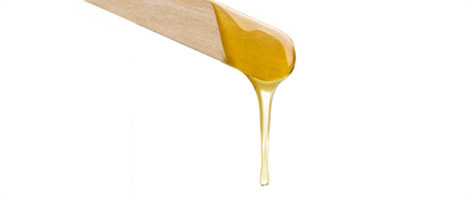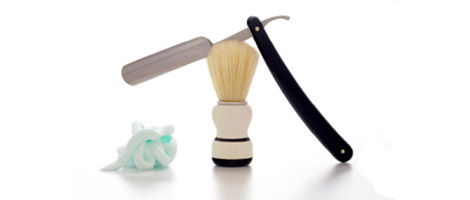
Waxing
Waxing is a form of hair removal involving the use of wax to pull unwanted hair out from the root. Individuals who can withstand the treatment's discomfort, and keep up with the necessary aftercare, can enjoy the many benefits of this system of hair removal. Depending on your hair type, the results from waxing can last between four to six weeks, making it a popular epilation option for both men and women.
How it's done
Using a spatula that resembles a tongue depressor, wax is applied to an area large enough to be covered by one cloth or paper strip. A thin layer is spread in the same direction that the hair grows. The strip gets pressed immediately into the wax and (while holding skin very taut), the strip gets pulled off in the opposite direction thereby removing the hair and wax. The process is repeated until all undesired hair is removed. The trick is to tear the strip off rapidly, making sure to pull ‘across the skin’ - not ‘up and away’ from it.
There are a few ways to perform this semi-permanent form of hair removal. The safest, most effective option is to have a professionally trained esthetician do the service. However, at-home waxing kits are widely available with an assortment of varieties to choose from: hot wax, warm wax, cold wax, and body sugaring. The main difference between each is a matter of how hot the wax needs to be in order to be spread it across the skin.
Another do-it-yourself wax treatment comes in the form of pre-prepared strips. These ‘express strips’ are ready to use, as the wax formula is already lined along the material. Peel away the protective barrier, apply to the designated area, and zip the hair off. This method is convenient, easier to use for beginners, and is growing in popularity. Hard wax is yet one more option. Though it takes longer, this method does not use cloth or paper strips, making it ideal for people with sensitive skin. It is warmed, applied in a thick layer across the skin, and allowed to cool/harden; then, it is ripped off in the same manner as a strip would be.
Does it hurt?
The level of pain you experience during a wax session depends on a number of factors, such as the waxer's technique/skill and the recipient's pain tolerance; also, for women, the point they're at in their menstrual cycle. Having a wax done on sensitive areas of the body, particularly for the first time, can be uncomfortable - and for some, downright painful. Fortunately, it does get easier over time, as the hair becomes finer and weaker with each successive treatment.
Aftercare
Though this hair removal method generally only needs to be performed monthly, if optimal results are expected the skin does require maintenance and aftercare. Depending on one's skin type, and the method used, it is realistic to expect redness and some soreness of the waxed area. This can be alleviated by applying a soothing gel or cream post-treatment. There are a few aftercare products available for purchase where wax kits are sold, the most popular of which is Azulene Oil. Derived from chamomile, the principle ingredient, it provides relief from skin irritation and its properties are touted for preventing ingrown hairs.
Ingrown hairs are potentially one of the most uncomfortable aspects of waxing, second only to the pain experienced during hair removal. When a hair regrows, it is meant to grow out of the skin; a hair that is in-grown is unable to penetrate past the surface of the skin, causing it to curl back onto itself or reenter the same follicle. The hair is then treated like a 'foreign object' by the body; the site becomes red, inflamed and infected - often ending up resembling a cyst.
Some people are prone to ingrown hair more than others, so much so that it could be the deciding factor as to whether or not they continue this form of hair removal. In order to mitigate your risk of ingrown hairs, the best measure is to exfoliate the wax site faithfully using a sponge or pair of exfoliating gloves and gentle soap. Also, avoid wearing tight or synthetic clothing as well as using heavy, pore-clogging creams.
Regrowth
A benefit of frequent waxing is that the temporary results can become permanent. With consistent waxing treatments some of the hair follicles get damaged in the process, causing hair to cease growing, regrowth to become sparser, and the length of time between waxes to increase. These advantages do come at a price; you have to become hairy before you get smooth. In order for the wax to ‘grab’ the hair, it has to be regrown to at least 1/4" long.
Pubic waxing
Many parts of the body can be waxed, including the eyebrows, under arms and legs for women, plus chest and back for men. Waxing the pubic area has also gained much popularity among females. A bikini wax involves removing hair that is visible near the crotch area of a bathing suit. Not for the faint of heart, an exotic or Brazilian wax entails removing all hair normally covered by underwear, including the top of thighs, pubic mound, vulva, perineum, buttocks, and anus. However, a small section of hair known as the ‘landing-strip’ can be left on the pubic mound; this can be shaped in any way though a narrow strip is the most common shape.
Pros and cons
The principal benefit of this waxing is convenience. The waxing process can take as little as ten minutes and only needs to be done once every four to six weeks. Compared to techniques such as shaving or depilatory creams, hair regrowth is softer and sparser, while recipients can enjoy smooth, hair-free skin for longer. At-home kits make this a reasonably priced hair removal technique, though having a professional do the treatment can decrease the possibility of injured skin.
On the downside, waxing is painful and not in-expensive. Using do-it yourself kits decreases the cost but it's difficult to reach certain parts of the body like the back and buttocks. Waxing requires excellent technique; if you don't know what you're doing, you run the risk of damaging skin – so, better to have a professional do it. Any recipient of a wax treatment may be vulnerable to pesky ingrown hairs, though its inconvenience is on par with razor burn and ingrown hairs due to shaving. Though regrowth after waxing gets progressively softer, it must be regrown to a wax-able length; this can be an annoyance at times, such as when you want to sport a clean bikini line while wearing a bathing suit.
Final thoughts
To wax, or not to wax? If you decide to go for it, consider the following. When choosing an aesthetician to perform the service, it's best to get a recommendation. If you want to go it alone, read the at home kit's instructions carefully, and don't go over the same patch of skin twice!
